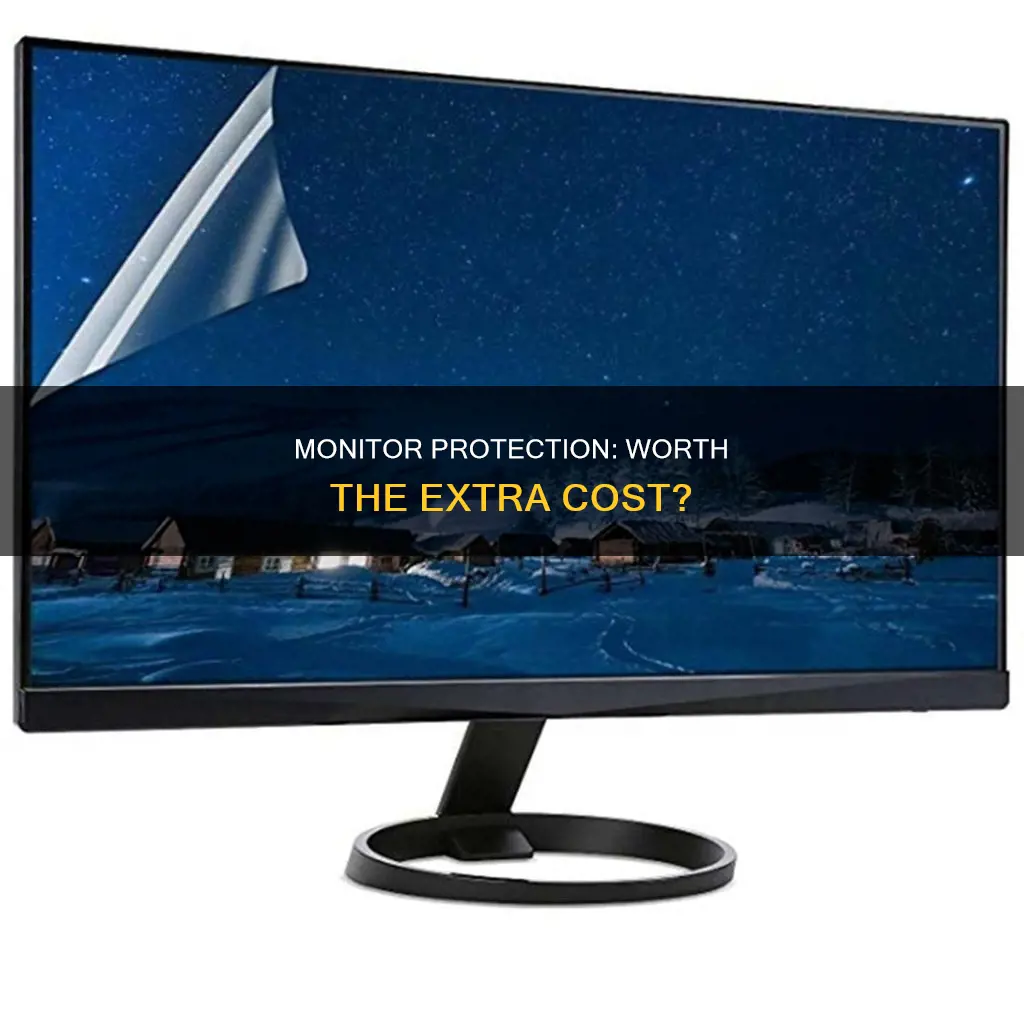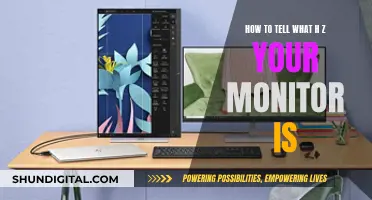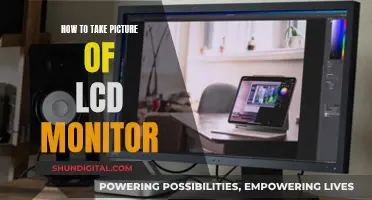
When buying a new monitor, you will likely be offered an extended warranty or protection plan. These plans are often pushed by retailers because they are lucrative, but they are not always worth the money for the consumer.
Extended warranties are usually limited in time and scope, and many people never end up using them. In fact, according to one source, only 15% of PC owners who bought an extended warranty used it to pay for repairs. Additionally, the cost of a single repair is usually less than the cost of an extended warranty.
However, monitors are becoming increasingly expensive and high-tech, so repairs can be costly. An extended warranty can provide peace of mind and safeguard against the risk of expensive repairs down the line.
Ultimately, the decision to buy protection for your monitor depends on your individual needs and preferences.
| Characteristics | Values |
|---|---|
| Cost of extended warranty | $39.99 - $71.99 for 2-4 years of coverage |
| Cost of monitor | $400 |
| Replacement cost | $120 |
| Manufacturer's warranty | 3 years |
| Average lifespan | 10-20 years |
| Repair cost | $136 median cost for electronic devices |
| Credit card coverage | Extended warranty may be included |
What You'll Learn
- Monitors are built to last 10-20 years, so an extended warranty may not be needed
- The cost of a single repair is usually less than the cost of an extended warranty
- Credit cards may offer extended coverage on purchases, including electronic devices
- Warranties often don't cover accidents or liquid damage
- Extended warranties are a very profitable business, with high margins

Monitors are built to last 10-20 years, so an extended warranty may not be needed
Monitors are built to last 10 to 20 years, so an extended warranty may not be needed. Modern computer monitors are designed to last for around 30,000 to 60,000 hours of use, which translates to 10 to 20 years before a display will encounter a critical failure. With proper care, they can last even longer.
When you buy a monitor, it typically comes with a manufacturer's warranty that covers defects for a limited time, usually a few years. This warranty is included for free and automatically kicks in upon purchase. However, these warranties often don't cover accidents or liquid damage, so it's important to read the fine print before making a decision.
Extended warranties are offered by retailers and third-party companies, and they can provide additional coverage beyond the manufacturer's warranty. However, they are often not worth the extra cost. The cost of repairing most items is usually less than the price of an extended warranty, and many products don't experience issues during the extended warranty period. Additionally, extended warranty repairs can take a long time and may have limited coverage.
Instead of purchasing an extended warranty, you can consider saving up a little money for possible repairs or using a credit card that offers extended warranty coverage. Your homeowner's or renter's insurance may also cover your laptop and other electronics in certain worst-case scenarios, such as vandalism, fire, or theft.
In summary, while extended warranties offer additional protection, they may not be necessary for monitors due to their long lifespan. It's important to weigh the benefits of the extra coverage against the cost and likelihood of needing repairs.
Hooking Up Three Monitors: Ultimate Guide to Triple Displays
You may want to see also

The cost of a single repair is usually less than the cost of an extended warranty
When you buy a new monitor, you will usually be offered the option to purchase an extended warranty. This is a protection plan that gives you extra time with the product should it break. However, for most people, this is not worth the money.
The cost of repairing most items is usually less than the cost of an extended warranty. For example, Consumer Reports calculated the median cost of a service plan for electronics to be $136, while the repair cost was only $16 more. In this case, it would be much cheaper to pay for the repair out of pocket if your monitor breaks.
Additionally, if something breaks on your monitor shortly after you buy it, the manufacturer's warranty will usually cover it. Many monitors come with a warranty of at least a few years, and if something breaks during that time, the manufacturer might replace it completely.
Extended warranties are priced based on the average cost of a repair. However, the vast majority of products do not experience electrical failures or other issues during the extended warranty term, so the extra coverage is often unnecessary.
Instead of purchasing an extended warranty, you could save the money you would have spent on it to pay for a repair if your monitor breaks. You could also look into whether your credit card offers extended coverage on purchases, or whether your state offers an "implied warranty" or "statutory warranty" that requires products to work defect-free for a certain period after purchase.
Monitor Upgrade: Can It Boost Your FPS?
You may want to see also

Credit cards may offer extended coverage on purchases, including electronic devices
Many credit card companies offer extended coverage on purchases, including electronic devices, which can be an alternative to buying separate extended warranty plans. This is known as an extended warranty, protection plan, service plan, or service contract.
As long as a product—even a refurbished product—has some kind of manufacturer warranty initially, most major credit cards offer an extended warranty. The caveat is that you have to use that card to purchase the product, of course.
Even a card with no fees might offer protection plans. You'll find this perk on cards from American Express, Capital One, Citi, Chase, and many more—but it's not guaranteed (Discover cards don't have it). It pays to check out the terms of service or give the card provider a call and ask; the number is on the back of the card.
Keep a copy of the receipt and original warranty when you buy—you may need them to make a claim on the credit card extended warranty, if it comes up.
The length of time the extended warranty protection benefits extend beyond the manufacturer’s warranty varies by card issuer and credit card. For example, some cards extend a warranty of three years or less by one additional year, while others add an extra year to original eligible warranties of five years or less.
The coverage limit also varies by card, with some offering a maximum of $10,000 per item and $50,000 per card member per calendar year.
In addition, in order for a purchase to be eligible for extended warranty protection, it must have a warranty to begin with. This will automatically exclude a lot of items, since most everyday purchases do not come with a warranty.
Connecting a Monitor to Your MacBook Air: A Simple Guide
You may want to see also

Warranties often don't cover accidents or liquid damage
Warranties are usually limited in time and scope. They are typically included for free with the purchase of a monitor, and nothing extra needs to be done by the consumer to activate them. However, these warranties are often limited warranties, covering only defects and not accidents or liquid damage.
Manufacturer warranties typically cover only defects in parts or labour. They do not cover accidental damage, such as cracking the screen or liquid damage. For example, Dell's basic and extended warranties do not cover user-caused damage to a peripheral device like a monitor.
Some companies offer additional additional "accidental damage" warranties, but these are usually only applicable to PC computers and not monitors. For example, Dell offers accidental damage protection on some devices, but this is just replacement-cost insurance.
If you are considering purchasing an extended warranty for your monitor, it is important to carefully read the fine print and understand what is covered. Many extended warranties do not offer as much coverage as one might think and may have a number of exclusions that could impact what is paid out if your monitor needs to be professionally maintained.
Monitoring Internet Usage: Who's Watching and How?
You may want to see also

Extended warranties are a very profitable business, with high margins
The high profitability of extended warranties is due to the fact that they are priced based on the average cost of a repair, which is often much lower than the cost of the warranty. In addition, the majority of products do not experience failures or issues during the extended warranty term, making the extra coverage unnecessary for most consumers.
Furthermore, many credit card companies offer extended coverage on purchases, including electronic devices, which can be an alternative to buying separate extended warranty plans. Additionally, local laws may offer protection in the form of an "implied warranty" or "statutory warranty", which guarantees that a product will work defect-free for a certain amount of time, usually four years.
While extended warranties can provide peace of mind and protection against costly repairs, they are often not worth the cost for most consumers. The high margins and profitability of the extended warranty business come at the expense of consumers, who are often paying for coverage they do not need.
It is important for consumers to carefully consider their options and understand the fine print before purchasing an extended warranty. In many cases, the best course of action is to save money for possible repairs or put it into a savings account, as the likelihood of needing repairs during the extended warranty term is relatively low for most products.
Monitoring Data Usage: Strategies for Effective Data Management
You may want to see also
Frequently asked questions
It depends on the individual consumer and the type of monitor they are looking to buy the warranty for. If you have purchased a high-quality display made from decent components, then its overall lifespan could be much longer than what is offered by the extended warranty.
An extended warranty is a great way to safeguard against the risk of costly repairs should one or more issues arise even two or three years down the line. It is also a way to buy peace of mind.
Repairing most items typically doesn't cost that much. The cost of a single repair is usually less than the cost of an extended warranty. Also, most protection plans will make you pay more upfront.







